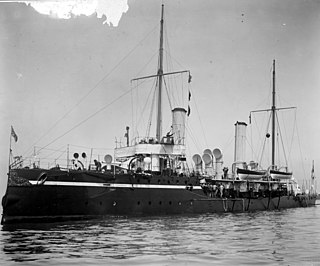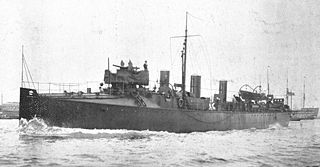
HMS Antelope was a Royal Navy Alarm-class torpedo gunboat. She was launched in 1893, reduced to harbour service from 1910 and was sold for scrapping in 1919.

HMS Andromache was an Apollo-class protected cruiser of the Royal Navy. William Henry White designed her, and she was built at Chatham Dockyard and launched on 14 August 1890. The total cost of construction was £186,234.
HMS Panther was a B-class torpedo boat destroyer of the British Royal Navy. She was completed by Laird, Son & Company, Birkenhead, in 1897.
HMS Griffon was a B-class torpedo boat destroyer of the British Royal Navy. She was completed by Laird, Son & Company, Birkenhead, in 1896.

HMS Scorpion was one of sixteen Beagle-class destroyers in service with the Royal Navy in the First World War. She was built by Fairfields Govan shipyards on the Clyde and was commissioned on 30 August 1910. She was a coal powered ship and as such was obsolete by the end of the First World War and was scrapped in 1921.
HMS Zebra was a "Twenty-seven Knotter" destroyer of the Royal Navy, later classified as part of the A Class. Zebra was built by Thames Iron Works and launched in 1895 as the fifth Royal Navy ship to be named Zebra. Entering service in 1900, Zebra was sold for scrap in 1914.

HMS Charger was a Charger-class destroyer which served with the Royal Navy. She was launched by Yarrow Shipbuilders at Poplar, London on 15 September 1894, served in home waters and was sold off in 1912.
HMS Haughty was a Hardy-class destroyer which served with the Royal Navy. She was launched by William Doxford & Sons on 18 September 1895, served in home waters, and was sold on 10 April 1912.

HMS Zephyr was one of two Fervent-class destroyers which served with the Royal Navy. She was launched on 10 May 1895 from Hanna, Donald & Wilson at Paisley, Scotland. She served in home waters, and was sold in 1920.

HMS Wizard was a Conflict-class destroyer built by the White shipyard for the Royal Navy, and launched on 26 February 1895. In 1910, she was reconstructed with only two funnels. She is believed to be the only destroyer fitted with in turning screws. She was sold in 1920.

HMS Roebuck was a Hawthorn Leslie three-funnel, 30-knot destroyer ordered by the Royal Navy under the 1898–1899 Naval Estimates. She was the twelfth ship to carry the name. She served during World War I and was broken up in 1919.
HMS Rother was a Palmer type River-class destroyer ordered by the Royal Navy under the 1902–1903 Naval Estimates. Named after the River Rother, east of Sheffield, South Yorkshire in England, she was the first ship to carry this name in the Royal Navy.

HMS Circe was a Alarm-class torpedo gunboat of the British Royal Navy. She was built by Sheerness Dockyard from 1890–1893. She was converted to a minesweeper in 1908–1909 and continued these duties during the First World War. Circe was sold for scrap in 1920.
HMS Leda was an Alarm-class torpedo gunboat of the British Royal Navy. She was built by Sheerness Dockyard from 1891–1893. She was converted to a minesweeper in 1908–1909 and continued these duties during the First World War. Leda was scrapped in 1922.

HMS Speedy was a Alarm-class torpedo gunboat of the British Royal Navy. She was built by Thornycroft from 1892–1894. She was converted to a minesweeper in 1908–1909 and continued these duties during the First World War. Speedy was sunk by a German mine on 3 September 1914.

HMS Jason was a Alarm-class torpedo gunboat of the British Royal Navy. She was built by the Naval Construction & Engineering Co. from 1891–1893. She was converted to a minesweeper in 1908–1909 and continued these duties during the First World War. Jason was sunk by a German mine on 7 April 1917.
HMS Gossamer was a Sharpshooter-class torpedo gunboat of the British Royal Navy. She was built at Sheerness Dockyard from 1889–1891. She was converted to a minesweeper in 1909 and continued these duties during the First World War. Gossamer was sold for scrap in 1920.
HMS Speedwell was a Sharpshooter-class torpedo gunboat of the British Royal Navy. She was built at Devonport Dockyard from 188–1890. She was converted to a minesweeper in 1909 and continued these duties during the First World War. Speedwell was sold for scrap in 1920.
HMS Skipjack was a Sharpshooter-class torpedo gunboat of the British Royal Navy. She was built at Chatham Dockyard from 1888–1891. She was converted to a minesweeper in 1908–1909 and continued these duties during the First World War. Skipjack survived the war and was sold for scrap in 1920.

HMS Ranger was a "twenty-seven knotter" torpedo boat destroyer of the British Royal Navy. Built by the Tyneside shipbuilder Hawthorn Leslie, Opossum was one of three destroyers built by Hawthorns that were ordered in 1894. She was launched in 1895 and completed in 1896. She remained in service during the First World War, where she was used for local patrol duties. She was sold for scrap in 1920.













